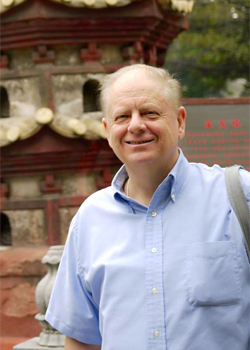Everyone has a creative process. But where does that intuition to try something new come from?
This Friday Paul Thagard, the 2013 Canada Council Killam Prize Winner for the Humanities, will visit Dalhousie to discuss what the brain just might be doing when its intellectual sparks are firing. His lecture into how the mind processes intuition takes place in the Scotiabank Auditorium of the Marion McCain Arts & Social Sciences Building this Friday at 4 p.m., with the cognition expert sharing his cutting-edge research into how the brain conveys creative intuition.
Sparking new ideas
Working from the premise that for an idea to be creative it must be new, valuable and surprising, Dr. Thagard’s interdisciplinary research explores how our brains help us interpret ideas in new ways.
“In fields like art, science and technology, people get hunches that turn out to be valuable,” says Dr. Thagard, who is a professor of philosophy and director of the Cognitive Science program at the University of Waterloo. “What I’m looking at is how the brain manages to bring those hunches to our attention.”
 Dr. Thagard (left) is using three computational mechanisms — neural representation, recursive binding and interactive competition — to try to understand why our brains react in ways that we identify as creativity. Simply put: brain cells fire in patterns, combine ideas to make something new, and make us more conscious of some combinations than others. When we become conscious of new and surprising ideas, this is what we call creative intuition.
Dr. Thagard (left) is using three computational mechanisms — neural representation, recursive binding and interactive competition — to try to understand why our brains react in ways that we identify as creativity. Simply put: brain cells fire in patterns, combine ideas to make something new, and make us more conscious of some combinations than others. When we become conscious of new and surprising ideas, this is what we call creative intuition.
An interdisciplinary field
Dalhousie philosophy professor Darren Abramson is doing research he describes as complementary to that of Dr. Thagard. Both stress that cognitive science is an inherently interdisciplinary field.
“The premise of cognitive science is that the study of the mind will require more than a single discipline,” Dr. Abramson explains. “Folks who do this kind of research often publish in areas like philosophy and computer science as well.”
“There is lots of room in Cognitive Science for different methods,” adds Dr. Thagard. “For example, I work closely with psychologists who use computer modelling.”
Making ideas accessible
It’s that interdisciplinary quality that makes Dr. Thagard’s research interesting from a variety of different perspectives, and he stresses that he strives to make his research as accessible as possible.
“It’s a general lecture for a broad audience,” Thagard says. “I use videos and other media to engage a broad range of interests.”
Dr. Abramson adds that across every discipline, “the fundamental goal is to understand ourselves and the world we live in.” Dr. Thagard’s lecture, he says, is “a unique opportunity for the Dalhousie community to engage with cutting edge research moving us towards that goal.”
Dr. Thagard speaks at 4 p.m. Friday in the Scotiabank Auditorium, Marion McCain Building. His lecure is titled: “Eureka! How Creative Intuition Results from Three Brain Mechanisms.”

